
A carillon ( KARR-ə-lon, kə-RIL-yən) is a pitched percussion instrument that is played with a keyboard and consists of at least 23 bells. The bells are cast in bronze, hung in fixed suspension, and tuned in chromatic order so that they can be sounded harmoniously together. They are struck with clappers connected to a keyboard of wooden batons played with the hands and pedals played with the feet. Often housed in bell towers, carillons are usually owned by churches, universities, or municipalities. They can include an automatic system through which the time is announced and simple tunes are played throughout the day.

St Botolph's Church is the Anglican parish church of Boston, Lincolnshire, England. It has been referred to as "Boston Stump" since it was constructed. Its tower is 266 feet 9 inches (81.31 m) tall, and was long used as a landmark for the Boston fishermen; on a clear day it can be seen from Norfolk. The church is a grade I listed building.

The Yale Memorial Carillon is a carillon of 54 bells in Harkness Tower at Yale University in New Haven, Connecticut.

Saybrook College is one of the 14 residential colleges at Yale University.
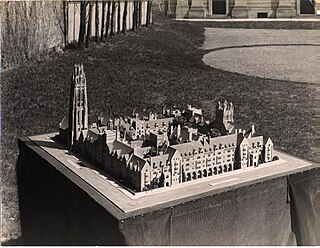
The Memorial Quadrangle is a residential quadrangle at Yale University in New Haven, Connecticut. Commissioned in 1917 to supply much-needed student housing for Yale College, it was Yale's first Collegiate Gothic building and its first project by James Gamble Rogers, who later designed ten other major buildings for the university. The Quadrangle has been occupied by Saybrook College and Branford College, two of the original ten residential colleges at Yale. The collegiate system of Yale University was largely inspired by the Oxbridge model of residential and teaching colleges at the University of Oxford and the University of Cambridge in the UK.

Branford College is one of the 14 residential colleges at Yale University.

Sterling Memorial Library (SML) is the main library building of the Yale University Library system in New Haven, Connecticut, United States. Opened in 1931, the library was designed by James Gamble Rogers as the centerpiece of Yale's Gothic Revival campus. The library's tower has sixteen levels of bookstacks containing over 4 million volumes. Several special collections—including the university's Manuscripts & Archives—are also housed in the building. It connects via tunnel to the underground Bass Library, which holds an additional 150,000 volumes.
The Peace Tower is a focal bell and clock tower sitting on the central axis of the Centre Block of the Canadian parliament buildings in Ottawa, Ontario. The present incarnation replaced the 55-metre (180 ft) Victoria Tower, after the latter burned down in 1916, along with most of the Centre Block; only the Library of Parliament survived. It serves as a Canadian icon and had been featured prominently on the Canadian twenty-dollar bill, directly adjacent to the depiction of Queen Elizabeth II, until the change to polymer.

James Gamble Rogers was an American architect. A proponent of what came to be known as Collegiate Gothic architecture, he is best known for his academic commissions at Yale University, Columbia University, Northwestern University, and elsewhere.

Rockefeller Chapel is a Gothic Revival chapel on the campus of the University of Chicago in Chicago, Illinois. A monumental example of Collegiate Gothic architecture, it was meant by patron John D. Rockefeller to be the "central and dominant feature" of the campus; at 200.7 feet it is by covenant the tallest building on campus and seats 1700. The current dean is Maurice Charles, an Episcopal priest.

The Cathedral Church of St Colman, usually known as Cobh Cathedral, or previously Queenstown Cathedral, is a single-spire cathedral in Cobh, Ireland. It is a Roman Catholic cathedral and was completed in 1919. Built on Cathedral Place, it overlooks Cork harbour from a prominent position, and is dedicated to Colmán of Cloyne, patron saint of the Diocese of Cloyne. It serves as the cathedral church of the diocese.

The Royal Carillon School "Jef Denyn" is a music school in Mechelen, Belgium, that specializes in the carillon. It is the first and largest carillon school in the world. The Belgian government defines it as an "International Higher Institute for the Carillon Arts under the High Protection of Her Majesty Queen Fabiola". The school has trained many of the foremost carillonneurs of the twentieth and twenty-first centuries and houses a rich archive and library.
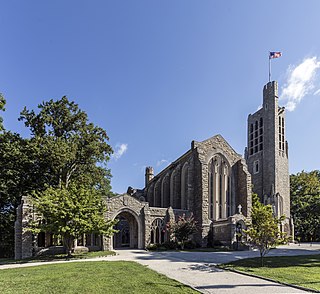
Washington Memorial Chapel in Valley Forge National Historical Park is a national memorial dedicated to General George Washington and an active Episcopal parish in Valley Forge, Pennsylvania. The church was inspired by a sermon preached by Anglican minister Reverend Dr. W. Herbert Burk, founder and first rector of the parish. The building was designed by architect Milton B. Medary. It was listed on the National Register of Historic Places on May 1, 2017, and is undergoing an active restoration campaign.
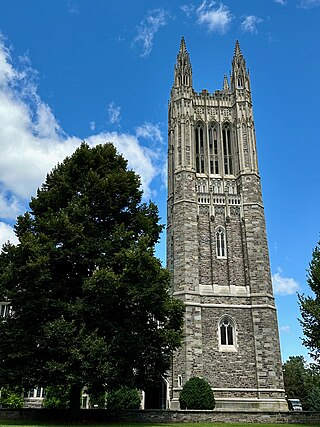
Cleveland Tower is a bell tower containing a carillon on the campus of Princeton University. Inspired by Boston College's Gasson Hall, the design by Ralph Adams Cram is one of the defining Collegiate Gothic architectural features of the university's Graduate College. The tower was built in 1913 as a memorial to former university trustee and U.S. President Grover Cleveland. A bust of the former president is the centerpiece of the grand chamber at the tower's ground level.
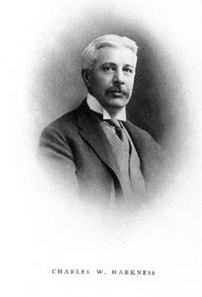
Charles William Harkness was a son of Stephen V. Harkness and his second wife, the former Anna M. Richardson.
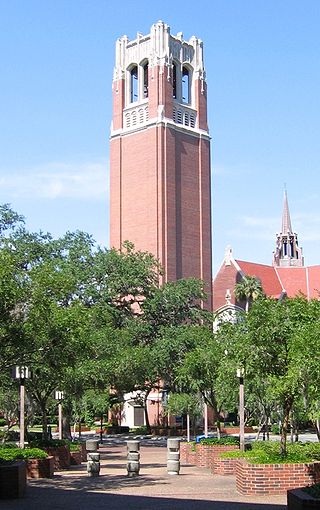
The Century Tower is a 157-foot-tall (48 m) bell tower containing a carillon in the center of the University of Florida campus in Gainesville, Florida, United States.

Norwood Memorial Municipal Building is a historic building located in Norwood, Massachusetts, United States.

Ronald Montague Barnes was an American carillonist, composer, and musicologist. He first began playing the carillon as a teenager at his hometown's church. In 1952, at 24 years old, he was appointed to play the carillon at the University of Kansas, where he developed as a musician. He was later the carillonist for the Washington National Cathedral from 1963 to 1975 and the University of California, Berkeley, from 1982 until his retirement in 1995. He was an involved member of The Guild of Carillonneurs in North America, having served as its president, vice president, and several other roles.





















